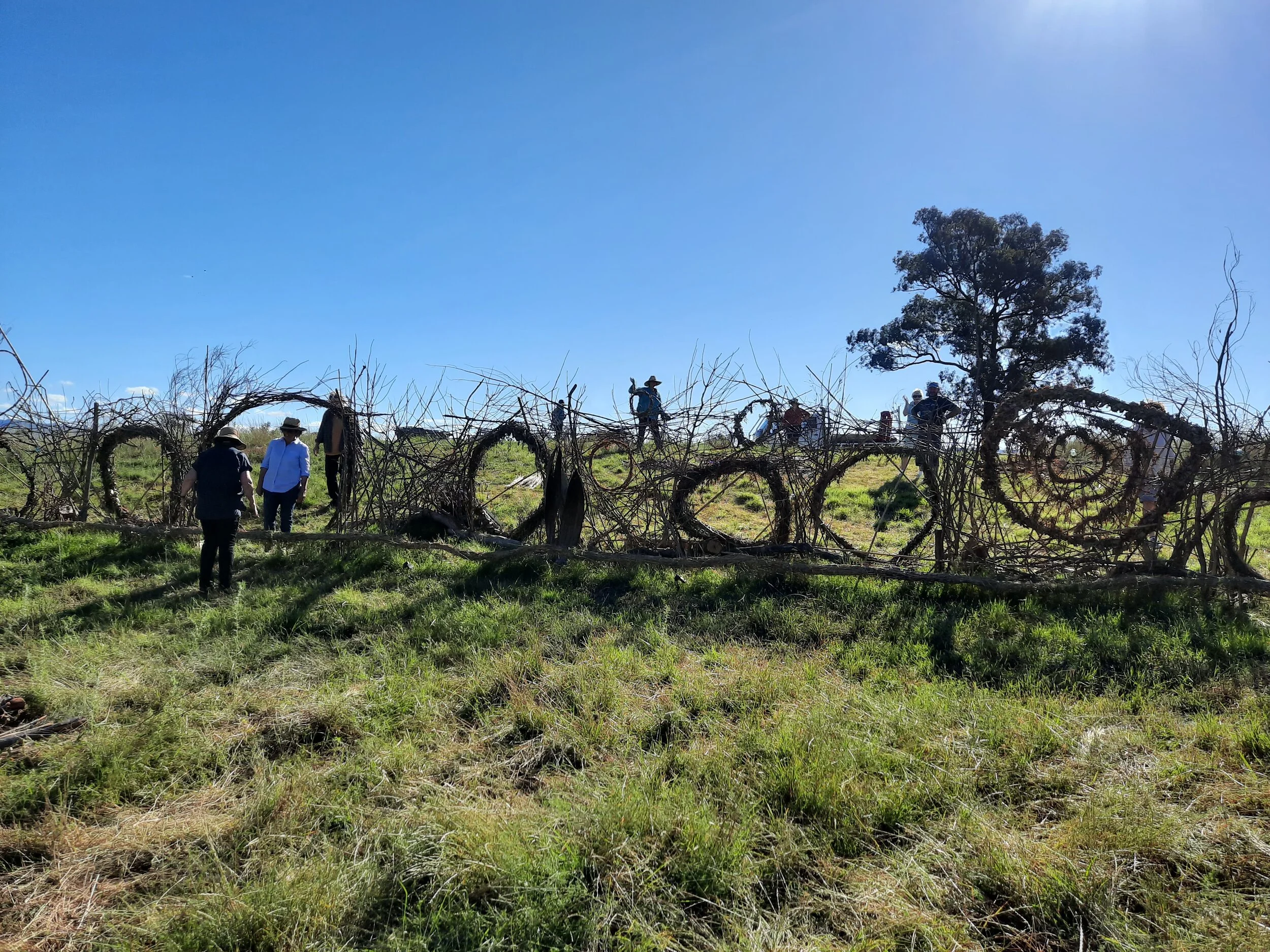By Leanne Thompson
The Capertee Hydrology Project began as an engagement within the larger Resilient Farmers Project that was led by Capertee Valley Landcare and produced in partnership with Cementa Inc. Both projects were designed to address the material and social impacts of long-term drought. The goal was to stage a series of practical, social and cultural activities that would reduce isolation and reinforce the support networks of the community, while also delivering practical knowledge to help landowners improve hydrological function in the landscape. Behind this was a broader ambition to create a catchment-wide approach that would see the community work to improve the hydrology of the entire valley.
The hydrology workshop at Glen Alice hall and valley residents in amongst the reeds during a field day at Umbiella Farm
The challenge was this: how can we generate awareness about water in the landscape while at the same time sparking conversations between neighbours? Plants, soils and microbes need access to slow moving water, the hydrating effects of which will support nature’s own regenerative processes. As artists, what methods could we employ to get as many people as possible working together regardless of fence lines, to engage in the big picture of restoring the land’s ability to hydrate across the entire catchment?
Peter Williamson and Kerrie Cooke discussing Georgie Pollard’s blackboard water catchment map. Hunting for water on the first Capertee Valley Landcare walk with some of the artists in the Capertee National Park.
Opportunities for education, a variety of perceptive lenses, and hands-on participation have all been in the toolkit of the project. The Capertee community is dispersed throughout the valley, so making opportunities to gather and be social has underpinned the other activities and brought joy and well-being, regardless of bushfire crises, extended drought and Covid19 impacting the program.
November 2019 to March 2020 was a hive of activity and everything had a common undercurrent; to investigate hydrological science, examine existing models and look at alternatives. The program hosted an open-air movie night with Damon Gameau’s ‘2040’, a talk by The Mulloon Institute’s Peter Hazel, field trips and workshops by Stuart Andrews from Tarwyn Park Training and workshop with scientists, Allan Nicholson and Andrew Wooldridge from Dept. Primary Industries and Environment. From the beginning it was important to weave in layers of cultural knowledge, artistic responses, food, music, and adventures into the terrain of the valley to bond the insights with experiential learning, making, growing, and walking.
Detail from Leanne Thompson’s light installation ‘Chain of Ponds’ outside Stuart Andrews’ Natural Sequence Farming talk and community dinner in January 2020. Walking the creeks to the find their source with Peter Swain.
Kerrie Cooke and Julie Gibson of Capertee Valley Landcare have been the magnets in the process, approaching community to request access or assistance and drawing people together. Five artists were invited to be involved:
Peter Swain, artist and traditional custodian of the Dabee welcomed everyone to Wiradjuri country, sharing cultural perspectives, knowledge and healing throughout the project and envisioning the culminating Water Ceremony held in November 2020; Georgie Pollard, KSCA artist and Kandos local who has been undertaking a deeply considered mapping project, connecting the watershed with people’s stories of relationship to water and textural woven elements; Peter Williamson and Lanny Mackenzie, both master weavers and artists who have been working with myself, KSCA artist Leanne Thompson to realise the ambitious land sculpture that plays with many of the concepts directing the project. Weaving was chosen for its intrinsic link to traditional knowledge, as a symbolic community activity (binding us together in action and story) and for the opportunity to incorporate discussion of wetland species (enhancing observation and awareness of resilient species around us). I have also been creating light installations to highlight water and wetland sites throughout the project, promoting a spatial awareness of these special places and contemplation of how water traverses the landscape.
Weaving workshop with Lanny, Peter and Leanne. The Capertee Weaving Water facebook group.
In March 2020, the social context of the project was derailed by Covid 19. Lanny, Peter and Leanne had to postpone their weaving workshops in the community. Instead, a small group was able to meet in late June, an instructional video filmed by trusty KSCA collaborator, Justin Hewitson and the participation taken online. What did emerge from this period of imposed physical isolation was an active Facebook group and new identity for the project community, Capertee Weaving Water. This platform has supported small groups meeting privately, sharing weaving skills, plant knowledge and the results of individual creative effort. It is inclusive and supported the group (now 50 members) through lockdown. The group also began making large woven circles to use as the basis for the final land sculpture.
Weaving Circle held at Bogee.
In October, members of the Hydrology Project collaborated with other KSCA artists Laura Fisher and Lucas Ihlein and their Land Studio project. Leanne, University of Wollongong art students and many valley locals joined forces to begin the sculptural intervention on Umbiella Farm. The resulting work, Draw the Line, foregrounds unseen water. From the plant material (phragmites australis – a wetland grass) harvested from Umbiella’s reappearing marshy areas, to the placement of the bound grass rope along a contour line (contours are transverse to the slope), the work signals the return of slow water to the land.
Land Studio: cutting, binding and drawing the continuous line of phragmites australis onto the contour.
In November, the entire Capertee Valley community were invited to help create a large landscape-based woven sculpture and be involved with the Water Ceremony (read about it here) over two consecutive weekends. Everyone was asked to weave a ‘circle’ from natural materials and then come along to the Umbiella site to ‘bind’ their circle into the growing work. Leanne ran a couple of after-school workshops at WayOut in Kandos to build lanterns for the lighting elements. These were great fun and produced some amazing results, and although the weather in November meant they couldn’t be used to light the installation, the kids had a chance to also engage with the project and the underlying concepts. Along the way and within Covid restrictions, a steady stream of people were involved in the weaving. They came from the valley, town, the city and other regions and helped bring the idea of a land sculpture into being.
Weaving and lantern workshops at WayOut and Newco in Kandos and on the farm in Glen Davis.
Even though Weaving Water is an ephemeral sculpture, over time the work will serve a pragmatic purpose in line with regenerative farming principles. It has been positioned along the contour and it will laterally distribute and slow down water and promote banded vegetation while it breaks back down to the earth. The woody structural elements should keep the livestock off while other plants have an opportunity to get going. For now, it has shaken off some of the exuberant vitality and joy of its making and is becoming something else; windswept, inhabited and growing. A slow and contemplative space of possibility in the midst of the paddock.
Thank you to the Capertee Valley community for your enthusiastic engagement and brilliant collaboration. And thanks for some very encouraging feedback:
“This whole project from beginning to end was the most wonderful demonstration of the connection between landscape, water, and community. The project developed an awareness of the vegetation and landscape within which we live and the untapped potential that lies within. Something our indigenous people have known & utilised for all times. Finally we are now listening to these wise & inherently knowledgeable people who can teach us to live so much more sustainably & leave a gentler footprint ....respecting our land & water. Mary Thirlwall.
“This work is a great example of what KSCA is all about, it is both a participatory work of art and the practice of adapting our culture to our changing environment, it is both making something beautiful and doing something useful, creating an image of the world we want to bring into being and disseminating knowledge and understanding about that transition.” Laura Fisher
The artists of this project have led the community into some unusual and speculative places and enabled new connections between diverse knowledge. These connections are complex, but creative interpretations allow time for us to slow down, just as we want the water to, giving us permission to soak it up and be renewed.
Want to find out more – follow these links:
https://www.facebook.com/groups/weavingwater/about/ (ask to join if you’re in the area)
https://www.ksca.land/capertee-valley-hydrology-project
KSCA blog posts: https://www.ksca.land/blogfeed/2019/11/14/a-night-in-the-capertee
https://www.ksca.land/blogfeed/2020/3/16/hydrology-and-walking
https://www.ksca.land/blogfeed/2020/7/26/weaving-water-workshop-june-2020
Video: https://www.youtube.com/watch?v=6Ou1t4nVO8s&feature=youtu.be
https://www.facebook.com/leanne.thompson.378/videos/1954106088053823/
Offshoots: Blue Tree Project
https://www.ksca.land/blogfeed/2020/10/29/introducing-land-studio
Capertee Weaving Water was supported by Create NSW and Regional Arts Australia





















